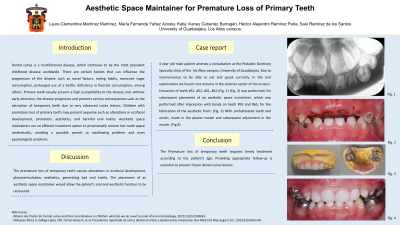Caries
344 - Aesthetic Space Maintainer for Premature Loss of Primary Teeth

- LM
Laura C. Martínez Martínez
Student
University of Guadalajara
University of Guadalajara
Tepatitlan, Jalisco, Mexico - SR
Saul Ramírez de los santos, n/a
University of Guadalajara
- hR
héctor A. Ramírez Peña, n/a
University of Guadalajara
- KG
Katia v. Gutiérrez Barragán, n/a
University of Guadalajara
- MY
María F. Yañez Acosta, n/a
Professor pediatric dentistry
University of Guadalajara
Tepatitlán, Jalisco, Mexico - CA
Carmen Celina Alonso Sánchez, University of Guadalajara, Pediatric Dentistry
Program director
Universidad de Guadalajara
Tepatitlan de Morelos, Jalisco, Mexico
Presenting Author(s)
Co-Author(s)
Research Mentor(s)
Program Director(s)
Introduction: Dental caries is a multifactorial disease, which continues to be the most prevalent childhood disease worldwide. There are certain factors that can influence the progression of the disease such as social factors, eating habits, excessive sugar consumption, prolonged use of a bottle, deficiency in fluoride consumption, among others. Primary teeth usually present a high susceptibility to the disease and, without early attention, the disease progresses and presents serious consequences such as the extraction of temporary teeth due to very advanced caries lesions. Children with premature loss of primary teeth may present sequelae such as alterations in orofacial development, phonation, aesthetics, and harmful oral habits. Aesthetic space maintainers are an efficient treatment option to provisionally restore lost tooth space aesthetically, avoiding a possible speech or swallowing problem and even psychological problems. Case report: 4 year old male patient attends a consultation at the Pediatric Dentistry Specialty clinic of the Centro Universitario de los Altos, University of Guadalajara. Due to inconvenience to be able to eat and speak correctly. In the oral examination we found root remains in the anterior sector of the incisors. Extraction of teeth #51, #52, #61, #62 was performed, for subsequent placement of an aesthetic space maintainer, which was performed after impression with bands on teeth #55 and #65, for the fabrication of the aesthetic front. with prefabricated teeth and acrylic, made in the plaster model and subsequent adjustment in the mouth.
Identify Supporting Agency and Grant Number:

.jpg)